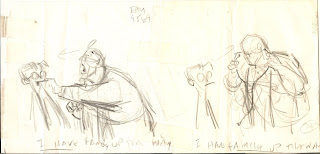More workbook and thumbnail sketches...
Workbook (WB) poses are designed to convey the basics...it is up to the animator to make the scene entertaining.
WB sketches (below) give the basic intent of the scene and indicate the camera move (upper right corner).

Thumbnail sketches (based on the sketches made on the x-sheet- see part 3) work out the action of the handshake, his walk toward camera, putting on the lab coat and reaching into medical bag to pull out the bone saw.
Though only his upper torso is visible, the whole body has to be kept in mind for believable animation.
Thumbnails to help visualize and work out the action (below- right #1 to left #14)...these are the drawings that I would show the directors to get their approval to proceed to animation.
The directors input...
Am I capturing the action as they envisioned?...do I need to add or omit some action, did I overlooked something?... after all, it is their movie.
Thumbnails to work out the mouth shapes for dialogue"...well, no time like the present..."
(this scene is presented in more detail in ...part 2)
Workbook sketches...
The scene starts out with the Doctor talking to Milo about the bone saw and what he can do with it...
and ends with him saying "...say ahh..."
The thumbnails of the action and dialogue...
Thumbnails to work out the action- into the medical bag goes the bone saw, out comes a tongue depressor...the dialogue "...stick out your tongue and say ahh..."

Thumb nailing (below) my way trying to find an interesting way for Dr. Sweet to look into Milo's mouth...
Dr. Sweet's monologue with Milo is loaded with questions of which he (Milo) cannot answer with several objects poked in his mouth in succession...
Thumbs to visually see if the mouth shapes are working for the Dr.'s line of dialogue "...fishing, I hate fishin'... and experimenting to see if the beakers can be introduced in an entertaining way (below, lower left).
Lower right thumbnails were probably done at a football game as the page contains a referee and player. I carry a sketch book with me at all times and when inspiration hits me I'm prepared to jot the thoughts on paper.
WB gag brings out the jokester in the Dr...
The animators job is to plus the scene by making it entertaining and appealing. By offsetting the beakers, having distance between them and having one tossed into the air made better presentation and staging without taking away from the original intent of the scene.


WB and thumbnails "...you too..."
until next time...





































